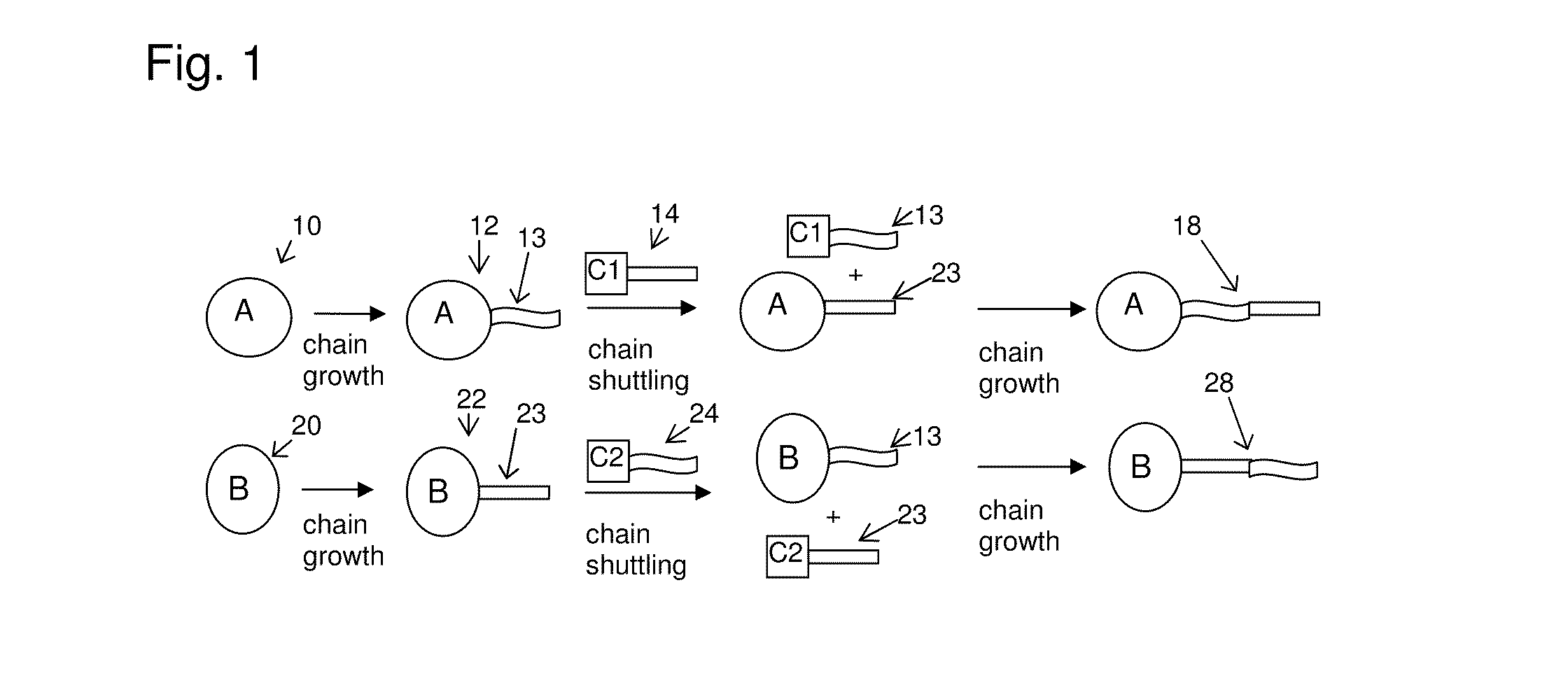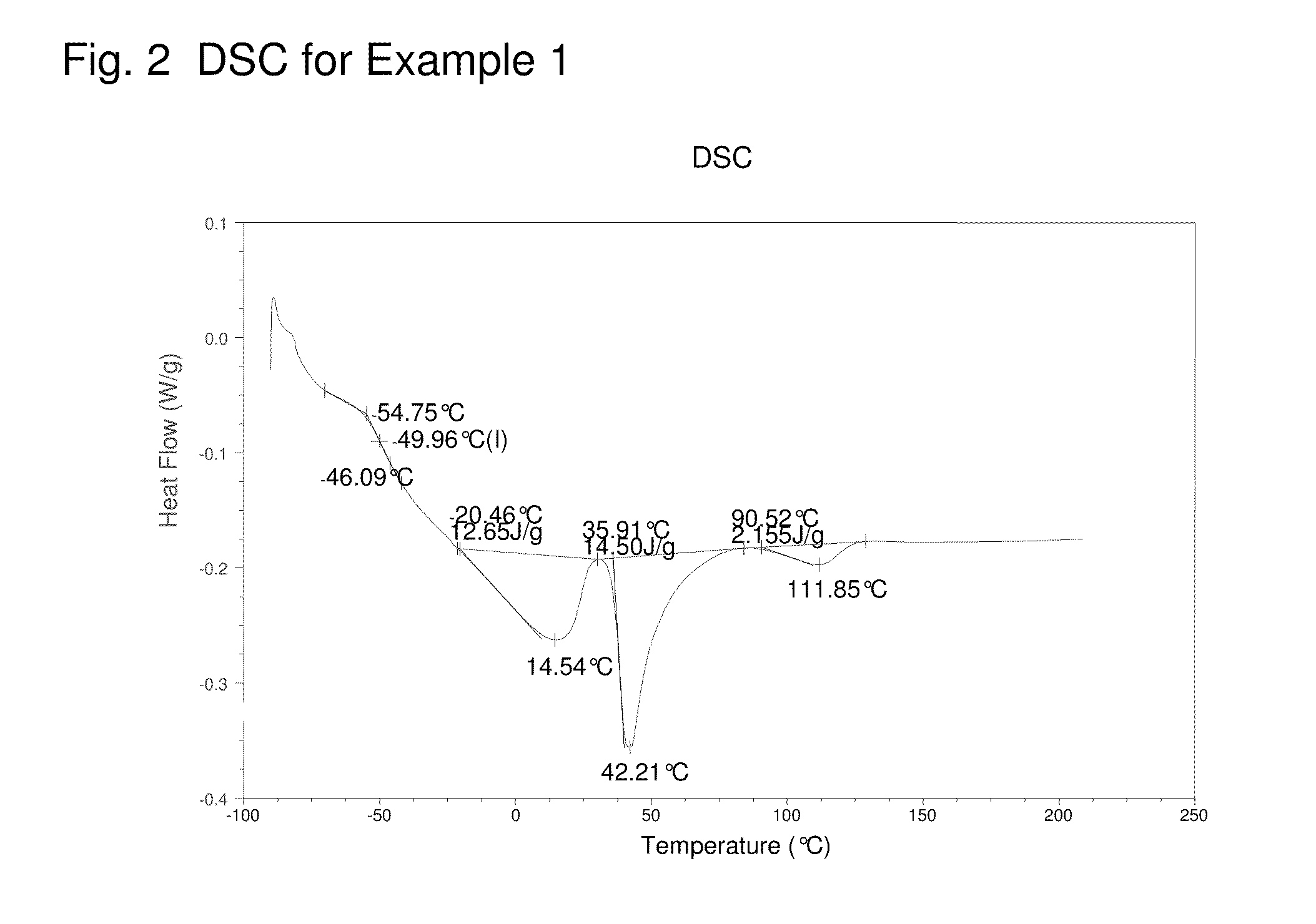Catalyst composition comprising shuttling agent for higher olefin multi-block copolymer formation
a technology of multi-block copolymer and catalyst composition, which is applied in the direction of textiles and paper, weaving, woven fabrics, etc., can solve the problems of poor process economics, limited monomer types that can be usefully employed in such methods, and low efficiency
- Summary
- Abstract
- Description
- Claims
- Application Information
AI Technical Summary
Benefits of technology
Problems solved by technology
Method used
Image
Examples
specific embodiments
[0673]The following specific embodiments of the invention and combinations thereof are especially desirable and hereby delineated in order to provide detailed disclosure for the appended claims.
[0674]1. A copolymer formed by polymerizing propylene, 4-methyl-1-pentene, styrene, or another C4-20 α-olefin, and a copolymerizable comonomer in the presence of a composition comprising the admixture or reaction product resulting from combining:
[0675](A) a first olefin polymerization catalyst,
[0676](B) a second olefin polymerization catalyst capable of preparing polymers differing in chemical or physical properties from the polymer prepared by catalyst (A) under equivalent polymerization conditions, and
[0677](C) a chain shuttling agent.
[0678]2. A copolymer formed by polymerizing propylene, 4-methyl-1-pentene, styrene, or another C4-20 α-olefin, and a copolymerizable comonomer in the presence of a composition comprising the admixture or reaction product resulting from combining:
[0679](A) a fi...
examples
[0758]The following examples are provided as further illustration of the invention and are not to be construed as limiting. The term “overnight”, if used, refers to a time of approximately 16-18 hours, the term “room temperature”, refers to a temperature of 20-25° C., and the term “mixed alkanes” refers to a commercially obtained mixture of C6-9 aliphatic hydrocarbons available under the trade designation Isopar E®, from Exxon Mobil Chemicals Inc. In the event the name of a compound herein does not conform to the structural representation thereof, the structural representation shall control. The synthesis of all metal complexes and the preparation of all screening experiments were carried out in a dry nitrogen atmosphere using dry box techniques. All solvents used were HPLC grade and were dried before their use.
[0759]MMAO refers to modified methylalumoxane, a triisobutylaluminum modified methylalumoxane available commercially from Akzo-Noble Corporation.
[0760]Catalyst (A1) is bis((2...
examples 1-3
, Comparatives A, B
General High Throughput Parallel Polymerization Conditions
[0768]Polymerizations are conducted using a high throughput, parallel polymerization reactor (PPR) available from Symyx technologies, Inc. and operated substantially according to U.S. Pat. Nos. 6,248,540, 6,030,917, 6,362,309, 6,306,658, and 6,316,663. Polymerizations are conducted at 120° C. using 1.2 equivalents of cocatalyst 1 based on total catalyst used (1.1 equivalents when MMAO is present). A series of polymerizations are conducted in a parallel pressure reactor (PPR) comprised of 48 individual reactor cells in a 6×8 array that are fitted with a pre-weighed glass tube. The working volume in each reactor cell is 6000 μL. Each cell is temperature and pressure controlled with stirring provided by individual stirring paddles. The monomer gas and quench gas are plumbed directly into the PPR unit and controlled by automatic valves. Liquid reagents are robotically added to each reactor cell by syringes and ...
PUM
| Property | Measurement | Unit |
|---|---|---|
| average particle size | aaaaa | aaaaa |
| average particle size | aaaaa | aaaaa |
| average particle size | aaaaa | aaaaa |
Abstract
Description
Claims
Application Information
 Login to View More
Login to View More - R&D
- Intellectual Property
- Life Sciences
- Materials
- Tech Scout
- Unparalleled Data Quality
- Higher Quality Content
- 60% Fewer Hallucinations
Browse by: Latest US Patents, China's latest patents, Technical Efficacy Thesaurus, Application Domain, Technology Topic, Popular Technical Reports.
© 2025 PatSnap. All rights reserved.Legal|Privacy policy|Modern Slavery Act Transparency Statement|Sitemap|About US| Contact US: help@patsnap.com



